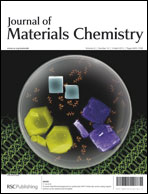Theoretical study of the bridging effect on the charge carrier transport properties of cyclooctatetrathiophene and its derivatives†
Abstract
The bridging effect on the charge transport properties of cyclooctatetrathiophene and its derivatives (systems 1–4) was investigated at the level of density functional theory (DFT). Insights into their geometries, frontier molecular orbitals, reorganization energies, transfer integrals and band structures were provided in detail. Increasing charge mobilities for both holes and electrons were predicted in cyclooctatetrathiophene derivatives as the number of bridging sulfur atoms increased. The improved charge transport from system 1 to 4 can be interpreted from two contributions: (i) decreased reorganization energy with improved molecular planarity under the consideration of intermolecular interactions; and (ii) enhanced transfer integral derived from the π-stacking arrangement for 2 and 3, and multidimensional S⋯S interactions are found to contribute to charge transport in system 4 besides π⋯π interactions. The charge transport properties were also analyzed with a band-like model and the results were in agreement with those gained from the hopping model in the fact that the paths with large transfer integrals are all along the directions with large dispersions in the valence band or conduction band.


 Please wait while we load your content...
Please wait while we load your content...